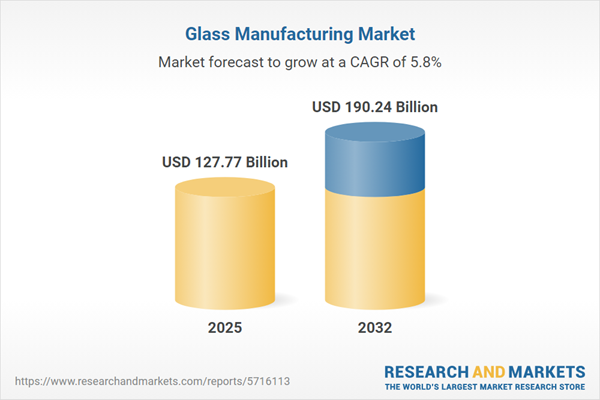Speak directly to the analyst to clarify any post sales queries you may have.
The glass manufacturing market is experiencing significant transformation as industry leaders prioritize digital adoption, sustainable practices, and advanced materials to remain competitive and responsive in a rapidly evolving landscape. Senior decision-makers are strategically navigating these shifts to drive operational efficiency and long-term growth.
Market Snapshot: Glass Manufacturing Market Overview
The global glass manufacturing market continues its upward trajectory, underpinned by advancements in material science and adoption of energy-efficient technologies. By 2024, the market size reached USD 120.83 billion, with robust momentum positioning the sector for substantial expansion to USD 127.77 billion in 2025 and a projected USD 190.24 billion by 2032. Demand is driven by the automotive, construction, electronics, and renewable energy sectors, where specialized glass products support innovation and regulatory compliance. The modern market's pace is set by evolving sustainability requirements and ongoing digital transformation impacting manufacturing models industry-wide.
Scope & Segmentation of the Glass Manufacturing Market
- Material Types: Aluminosilicate glass is chosen for industrial and environmental durability; borosilicate glass is favored for thermal resistance in manufacturing and laboratory environments; lead glass is deployed for high optical performance in technical and display contexts; soda lime glass dominates construction and packaging due to versatility.
- Key Applications: Glass is used in vehicle glazing, lighting solutions, architectural facades, electronic displays, optics, and renewable energy systems, supporting demand across multiple high-growth sectors.
- Manufacturing Processes: Float, blown glass forming, fiber drawing, fusion, and drawn methods provide both scalable high-volume production and specialty solutions, ensuring cost efficiency and technical advancement in packaging, laboratory, and architecture segments.
- Sales Channels: Markets are served through direct sales to original equipment manufacturers, digital procurement platforms, distributor partnerships, and aftermarket solutions, reflecting the complex and evolving buyer ecosystem.
- Product Types: Container glass underpins packaging industries; fiberglass is pivotal in composite material production; float glass supports architectural requirements; specialty glass enables laboratory, medical, and precision optical use cases.
- Geographic Regions: The Americas benefit from automotive and ongoing infrastructure projects; Europe accelerates digital factory adoption and regulatory leadership; the Middle East and Africa experience increasing infrastructure investment; Asia-Pacific diversifies into electronics, industrial, and construction glass segments.
- Key Players: Compagnie de Saint-Gobain S.A., Nippon Sheet Glass Co., Ltd., AGC Inc., Guardian Industries Corp., Türkiye Şişe ve Cam Fabrikalari A.S., Xinyi Glass Holdings Limited, Fuyao Glass Industry Group Co., Ltd., Vitro S.A.B. de C.V., Cardinal Glass Industries, Inc., and Central Glass Co., Ltd. contribute to global innovation, capacity, and supply resilience.
Key Takeaways for Senior Decision-Makers
- Integrating digital twin technologies and leveraging real-time analytics strengthens transparency, enabling manufacturers to quickly adapt to policy updates and shifting customer expectations.
- Prioritizing use of recycled materials and advanced composites enhances both sustainability outcomes and regulatory standing while optimizing costs across product lines and regions.
- Strengthening regional supply chains increases resilience and operational continuity, essential for mitigating the impacts of global market disruptions and logistical risks.
- Forming partnerships with suppliers and technology providers supports efficient deployment of innovative glass products in key application sectors like transportation, energy, and construction.
- Focusing R&D and product pipeline development on local trends in construction and electronics solidifies market relevance and fosters competitive differentiation across regions.
Tariff Impact on the Glass Manufacturing Value Chain
Shifting tariff regulations, particularly within the U.S., are altering input sourcing decisions, cost-management strategies, and overall supply chain reliability. To manage volatility, industry leaders emphasize regional collaboration, invest in optimized furnace and logistics operations, and prioritize regulatory environments that support steady business operations. These strategies are especially critical for specialized glass manufacturers facing ongoing trade uncertainty in global markets.
Methodology & Data Sources
This report is based on direct interviews with executive leaders and materials specialists, supplemented by analysis of recent regulatory frameworks and referenced industry publications. Insights are verified against current market practices and policy developments to ensure their relevance for executive stakeholders.
Why This Report Matters for Glass Industry Executives
- Enables leaders to integrate emerging manufacturing technologies and sustainability models that address evolving industry standards and operational requirements.
- Offers practical guidance on navigating policy shifts, optimizing supply chains, and expanding glass applications to improve planning and manage risk.
- Supports informed procurement, strategic partnership development, and competitive positioning for successful expansion in both established and growth markets.
Conclusion
This report empowers executive teams to guide their organizations through sector transformation, aligning technology priorities and strategic initiatives with customer and regulatory shifts.
Additional Product Information:
- Purchase of this report includes 1 year online access with quarterly updates.
- This report can be updated on request. Please contact our Customer Experience team using the Ask a Question widget on our website.
Table of Contents
3. Executive Summary
4. Market Overview
7. Cumulative Impact of Artificial Intelligence 2025
Companies Mentioned
The companies profiled in this Glass Manufacturing market report include:- Compagnie de Saint-Gobain S.A.
- Nippon Sheet Glass Co., Ltd.
- AGC Inc.
- Guardian Industries Corp.
- Türkiye Şişe ve Cam Fabrikalari A.S.
- Xinyi Glass Holdings Limited
- Fuyao Glass Industry Group Co., Ltd.
- Vitro S.A.B. de C.V.
- Cardinal Glass Industries, Inc.
- Central Glass Co., Ltd.
Table Information
| Report Attribute | Details |
|---|---|
| No. of Pages | 192 |
| Published | November 2025 |
| Forecast Period | 2025 - 2032 |
| Estimated Market Value ( USD | $ 127.77 Billion |
| Forecasted Market Value ( USD | $ 190.24 Billion |
| Compound Annual Growth Rate | 5.8% |
| Regions Covered | Global |
| No. of Companies Mentioned | 11 |









